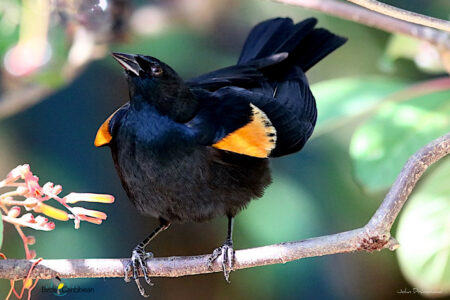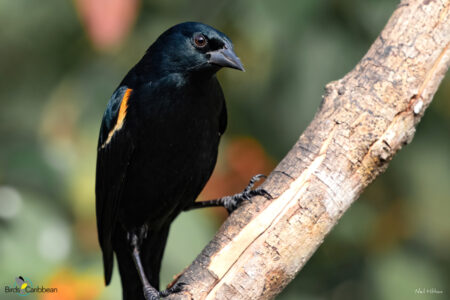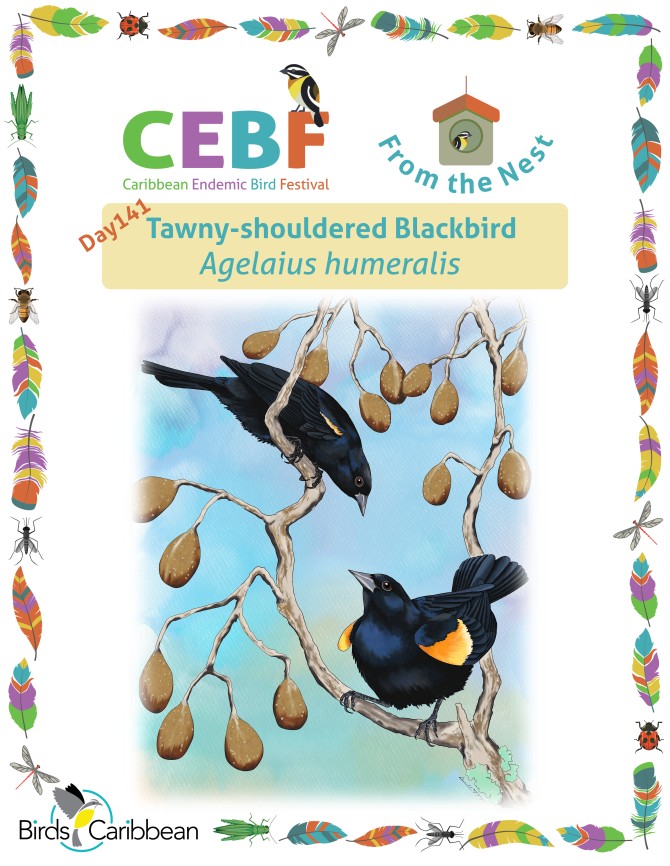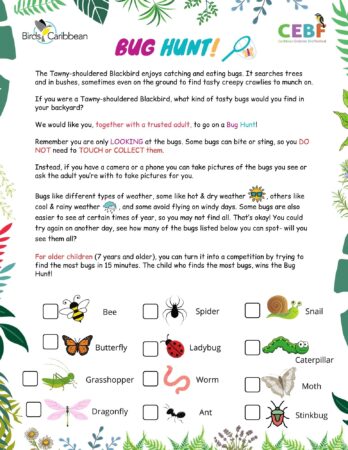Celebrate the Caribbean Endemic Bird Festival (CEBF) with us! Our theme in 2024 is “Protect Insects, Protect Birds”—highlighting the importance of protecting insects for birds and our environment. Have fun learning about a new endemic bird every day. We have colouring pages, puzzles, activities, and more. Download for free and enjoy learning about and celebrating nature!
Endemic Bird of the Day: Tawny-shouldered Blackbird
Blackbirds love to hang out with other blackbirds and this beloved endemic is no exception. The Tawny-shouldered Blackbird is considered nearly endemic to Cuba where locals call it ‘Mayito.’ There is a small relict population in Haiti. Like other blackbirds, it belongs to the Icteridae family, which includes other cool endemics like the Greater Antillean Grackle, Cuban Blackbird, and Red-shouldered Blackbird. It forms mixed flocks with these species. It even flocks with Shiny Cowbirds—which are known to parasitize their nests! Being in a mixed flock affords Tawny-shouldered Blackbirds better protection from predators and possibly improves foraging efficiency. At night, their raucous roosts can be immediately identified in parks and tree groves.
Male and female Tawny-shouldered Blackbirds look alike. Both have black plumage, and distinctive tawny (orange-ochre) patches on the shoulders with a yellowish-cream border. This shoulder patch is particularly striking in males during the breeding season. Females are duskier and lack the bluish gloss of the males. These relatively small birds measure approximately 7.5 inch to 8.7 inch.
Not all species of songbirds can sing duets with their mates but Tawny-shouldered Blackbirds rather delightfully can! Both males and females have melodious voices with males usually leading the serenade. Solo songs are a shrill “shuh-riii-iii” and calls are a short and strong metallic “chic-chic.”
Tawny-shouldered Blackbirds are monogamous, nesting in trees or bushes near water, and prefer colonial nesting, with many nests close to each other. They nest from April to August with chicks fledging the nests mostly between May and July. Females take the lead in constructing the nests using dried grass, moss, twigs, hair, and feathers. Clutches comprise 3–4 bluish to greenish eggs with brown spots.
In Cuba look for these black beauties in woodlands and woodland edges, farmlands, and rice fields. In Haiti, they occur along channels of dry open woodlands. They can also be found in Cuba’s cities and neighbourhoods, and are not restricted to wetlands like their counterpart, the Red-shouldered Blackbird. Their omnivorous diet of insects, seeds, fruits, and nectar allows them to adapt to a variety of habitats.
While primarily sedentary, vagrant Tawny-shouldered Blackbirds have been recorded in the southeastern United States and the Cayman Islands, possibly blown off route during storms and hurricanes.
Fortunately, the Tawny-shouldered blackbird is not globally threatened. Although common in larger islands in the Cuban archipelago, it is rare in Haiti, mainly in the western part, and the current status of its populations there is unknown.
Learn more about this species, including its range, photos, and calls here. Great news! If you’re in the Caribbean, thanks to BirdsCaribbean, you have free access to Birds of the World and you can find out even more in the full species account of this bird!
Thanks to Arnaldo Toledo for the illustration and Ailén Anido Escalona for the text!
Colour in the Tawny-shouldered Blackbird
Download our West Indies Endemic Bird colouring page. Use the photos below as your guide, or you can look up pictures of the bird online or in a bird field guide if you have one. Share your coloured-in page with us by posting it online and tagging us @BirdsCaribbean #CEBFfromthenest
Listen to the song of the Tawny-shouldered Blackbird
The song of the Tawny-shouldered Blackbird is made up of long buzzing notes, sometimes interspersed with short higher-pitched ‘buzzes’. Both males and females will sing, sometimes together.
Puzzle of the Day
Click on the image below to do the puzzle. You can make the puzzle as easy or as hard as you like – for example, 6, 8, or 12 pieces for young children, all the way up to 1,024 pieces for those that are up for a challenge!


Activity of the Day
FOR KIDS : The Tawny-shouldered Blackbird enjoys catching and eating bugs. It searches trees and in bushes, sometimes even on the ground to find tasty creepy crawlies to munch on. Perhaps catching a moth, a tasty worm, or a spider!
Imagine you are a Tawny-shouldered Blackbird in search of a meal. In today’s activity you will go exploring and find out what bugs there are in your backyard in our fun bug hunt!
Follow our instructions and see how many different types of bugs you can find! Perhaps you will spot a butterfly or a bee flitting past? Remember to just look at the bugs and not to touch or collect them.
You can check the ones you see off on our list, and perhaps take some photos of them?
FOR KIDS AND ADULTS : Enjoy this video of Tawny-shouldered Blackbirds in the wild!



